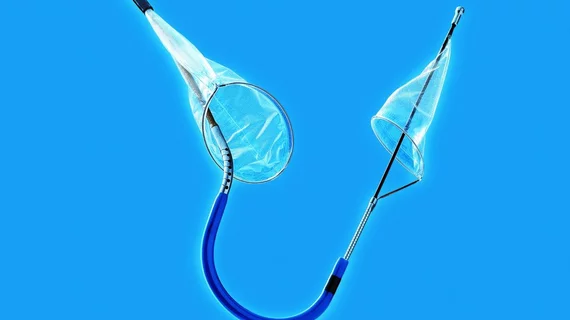Nearly all transcatheter heart valves (THVs) leave debris following aortic valve replacement, reinforcing the potential for embolic protection devices to reduce the burden of silent brain infarctions and future strokes.
Tobias Schmidt, MD, and colleagues made this observation after studying the material captured by Sentinel Embolic Protection Devices (manufactured by Claret Medical) during two prospective studies. The pooled analysis contained 246 patients implanted with four different transcatheter aortic valves that were commercially available at the time: the Sapien 3 and Sapien XT from Edwards Lifesciences, the Evolut R from Medtronic and the Lotus from Boston Scientific, which has been taken off the market until at least 2019 due to an issue with its locking mechanism.
Ninety-nine percent of all patients had some debris captured by the Sentinel filters, while 53 percent had a particle of at least one millimeter—a threshold that was used “because emboli of this size can cause significant vessel obstruction,” according to Schmidt et al.
The authors also analyzed the average number of particles and the total particle area captured by valve type. Each valve had patients with high totals for these measurements, although the frequency of large particles and mean total particle areas were significantly higher in Lotus and Evolut R patients than those given Sapien valves.
“There are no known studies reporting direct correlations between size or quantity of embolic material traveling to the brain and overt stroke,” Schmidt and colleagues wrote in JACC: Cardiovascular Interventions. “It seems logical, however, that the higher the amount of debris or the larger the size of debris traveling to the brain, the higher the likelihood of cerebral damage.”
Even though the Sapien balloon-expandable devices were linked to less debris than the others, the researchers noted “the high rate of large particles over all THV types demonstrates the importance of cerebral protection” regardless of valve selection.
More women were treated with Evolut R valves and more patients receiving those THVs had pre- and post-dilatation performed. The authors attempted to mitigate these differences with multivariable adjustment but acknowledged they could have confounded their results.
In a related editorial, three physicians from West Virginia University Heart and Vascular Institute disagreed with Schmidt et al.’s inference that the Sentinel device’s near-constant capture of debris is enough to support the universal use of embolic protection devices (EPDs) during TAVR.
“One may speculate that patients who had large debris captured in the filter would have developed smaller lesions on magnetic resonance brain imaging (and perhaps had fewer clinical strokes), because these large debris were prevented from traveling to the brain. However, these data are not available,” wrote Mohamad Alkhouli, MD, Partho P. Sengupta, MD, and Vinay Badhwar, MD.
“Considering the lack of clinical correlation, the study’s findings, albeit interesting, should be viewed as hypothesis generating and not as conclusive added evidence supporting the routine use of EPDs in all TAVR procedures.”
According to the editorialists, the next steps in the field of embolic protection with TAVR include developing prediction models for periprocedural strokes and cognitive decline, conducting post-marketing studies to assess EPDs in larger patient groups and incorporating neurologists and neuroradiologists into the assessment of subclinical neurological events.

